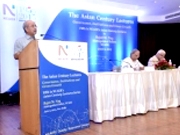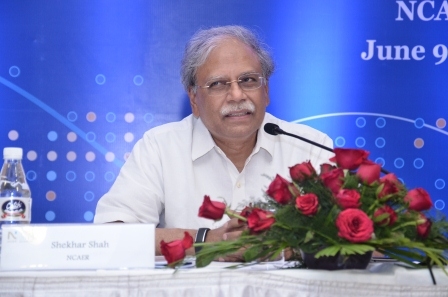Good governance and strong institutions are key enabling elements of sustainable growth. Rule of law, predictability and accountability are fundamental bedrocks of good governance, which in turn are necessary conditions for good development, and will be the main focus of this lecture. At the same time, Asia’s growth will not be sustainable if it is not simultaneously green. Asia’s contribution to global greenhouse emissions will be substantial as the region grows. What should be Asia’s role in future global accords on climate change? The fifth and final lecture in this stimulating Asian Lecture Series weaved the strands of institutions and governance, inclusive, green and clean growth to argue that an Asian Century is indeed plausible but not inevitable. Sanjaya Baru, Director for Geo-Economics and Strategy at the International Institute of Strategic Studies in London as commentator for this lecture presented his views on the topic to a captivated the audience and discussions followed.
Regional Cooperation and Integration
May 28, 2015
India International Centre, New Delhi
Asia’s prosperity and security in an increasingly interconnected and interdependent world would require greater cooperation among itself in a spirit of open regionalism and not fortress Asia. Sub-regional cooperation initiatives have flourished, some more than others in various parts of Asia and the prospects of garlanding them leading to a Pan Asian integration will be assessed in this lecture. Rule of law, predictability and accountability are fundamental bedrocks of good governance, which is a key condition for sustainable growth. In this fourth in the series of five lectures, Mr Nag discussed on why strong institutions are equally necessary to deliver development results and deliver economic progress, social justice and welfare for all and what should be their roles. Mr Nag presented a very thought provoking and persuasive case on regional cooperation, which was well attended by researcher, professionals and students. Mr Shyam Saran, Chairman of Research and Information System for Developing Countries, as discussant for the lecture , presented his comments on the topic. Q & A with the audience and discussions over the dinner followed.
Addressing Infrastructure Deficits and Transforming Finance in Asia
May 12, 2015
NCAER Conference Room
Much of Asia is still plagued by severe physical infrastructure deficits. This lecture addressed the important challenges of meeting such infrastructure deficits, both hard and soft, and how they could be financed from both public and private sources. Institutional arrangements for meeting the infrastructure challenges in Asia, including through public private partnerships will be discussed. As Asia’s share in the global economy grows, it should also have proportionately similar shares of financial assets to efficiently recycle and allocate its huge savings and foreign reserves. In his third in the series of five lectures, Rajat Nag discussed on how this transformation will unfold and also address the important aspects of financial inclusion.
Asian Demographics and the Imperatives of High-productivity, Job-creating Growth
April 28, 2015
NCAER Conference Room
For aging Asia, productivity growth will have to be a priority, for which an enabling environment for innovation and enhanced use of technology will be key. While East Asia is aging rapidly, South and Central Asia are still relatively young and growing. Such a large young population can bring demographic dividends by enhancing consumption, saving and growth, but can also be a demographic disaster if productive employment opportunities for the young cannot be found. Without remunerative jobs, the economy would not accumulate wealth to eventually pay for the old-age care of this large population when it is much older. In his second in the series of five lectures, Mr Nag discussed on how Asia will manage these challenges. Professor Abhijit Sen from Jawaharlal Nehru University, as discussant for this lecture, also shared his views.
Asia’s Two Faces and the Need for Inclusive Growth
March 31, 2015
Alliance Francaise Auditorium
Many have termed the 21st century as the Asian Century. Asia’s economic growth has been spectacular over the past several decades: it accounts today for over a quarter of global GDP. Three of the five largest economies in the world today are in Asia. And millions have been lifted out of poverty. Asians today are richer, healthier, more educated, and live longer than they did a generation back. But the region also faces severe development challenges. Continuing poverty—two thirds of the world’s poor still live in Asia—rising inequality, social deprivation, environmental degradation, gender bias, food, energy and water insecurity, and poor physical and social infrastructure pose many pressing challenges. If these challenges go unmet, Asia could get caught in a “middle income” trap thus rendering the dream of an “Asian Century” just that: a dream. Delivering the first in a series of five special lectures, Rajat Nag spoke on need to pursue an inclusive growth strategy to meet the challenges of the diverging two Asias.
NCAER’s organised a five-lecture series on the Asian Century by its Distinguished Fellow Rajat M. Nag, spread over a period of few months. Building a very thought provoking and persuasive case on regional cooperation, the lecture series examined the challenges that Asia must confront and also the opportunities that it must exploit to achieve the potential of an Asian Century, a proposition that he will show is plausible, but not inevitable. The lectures covered, Asia’s population demographics; the need to pursue an inclusive growth strategy; green growth and the competition for natural resources; infrastructure deficits and transforming finance; and, finally, governance, institutions, and regional integration.
Rajat Nag was until 2014 the former Managing Director-General of the Asian Development Bank. Besides joining NCAER, he is currently the Chair of the Look East Council of the Indian Chamber of Commerce and is a Visiting Professor at the Asian Institute of Management in Manila. Mr Nag began his professional career at the Bank of Canada, and held senior positions in consulting before joining the ADB. He has engineering degrees from IIT, Delhi and the University of Saskatchewan. He also has an MA in Business Administration from Canada and in Economics from the London School of Economics.











